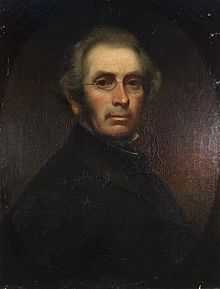John Kelso Hunter

John Kelso Hunter (15 December 1802 – 3 February 1873) was a self-taught Scottish portrait painter and author of two books.[1]
Life
Hunter was one of three children born to William Hunter and Isbald Logan, he had an elder brother George (Born: 14/10/1801) and a younger sister Susannah (Born: 27/10/1805). John was born at Dankeith, South Ayrshire, and he was a relation to the McCallums of Troon. His father was a gardener at a South Ayrshire estate owned by Lieutenant-Colonel William Kelso, he died when Hunter was 8 years old. As a young child, Hunter was employed as a herd-boy on the Kelsos' estate, and he was then apprenticed to a shoemaker. When his indentures expired, he settled at Kilmarnock. He taught himself portrait painting while continuing his work as a shoemaker.[1]
Hunter moved to Glasgow, where he was employed alternately as an artist and a shoemaker. In 1847 he exhibited a portrait of himself as a cobbler at the Royal Academy, London;[1] it was the only piece of his to be displayed there. He exhibited his painting "A Man's Head" at the Annual Exhibitions of the Royal Scottish Academy in 1849. After 9 years, he gave the Academy his formal self-portrait piece. He contributed three other works, "A Roadside Inn, Ayr" in 1868 and "From Above Port-Glasgow" and "Self Portrait as a Shoemaker" in 1872.

During 1861 and 1873, Hunter exhibited seven paintings at the Royal Glasgow Institute of Fine Arts:
- 1861 - 'Self Portrait'
- 1862 - 'Dreghorn, Ayrshire'
- 1871 - 'The Reader'
- 1872 - 'Loch Lomond, from Mount Misery' and 'Gourock - looking up the Clyde'
- 1873 - 'Self Portrait as a Shoemaker' and 'From Above Port-Glasgow'
In 1868 he published his first book, The Retrospect of an Artist's Life, subtitled Memorials of West-Country Men and Manners of the Past Half Century.[2] Acquainted in his youth with many who had known Robert Burns, and with some of the heroes of the poet's verse, Hunter embodied these recollections in a volume entitled Life Studies of Character, printed in 1870. The book throws much light on the works of Burns, especially on the original of Dr. Hornbook, and faithfully describes the society into which the poet was born. Valuable notices are supplied of the song writer, Tannahill, and other minor poets of the north.
Hunter died on 3 February 1873 at Pollokshields, Glasgow.[1]
Family
On 9 August 1822 Hunter married Agnes Willock in Low Church, Kilmarnock. The couple had 13 children over a period of 22 years.
- William Hunter - Birth: 26 January 1823 (Kilmarnock, Scotland) Death: Unknown
- Isabella Hunter - Birth: 14 April 1824 (Kilmarnock, Scotland) Death: 29 December 1836 (Kilmarnock, Scotland)
- John Kelso Hunter - Birth: 4 June 1826 (Kilmarnock, Scotland) Death: 2 March 1858 (Glasgow, Scotland)
- Helen Hunter - Birth: 29 December 1827 (Kilmarnock, Scotland) Death: Unknown
- George Hunter - Birth: 9 June 1828 (Kilmarnock, Scotland) Death: 12 May 1838 (Kilmarnock, Scotland)
- Anne Hunter - Birth: 22 November 1830 (Kilmarnock, Scotland) Death: 1898 (Beechworth, Victoria, Australia)
- David Hunter - Birth: 19 May 1832 (Kilmarnock, Scotland) Death: Unknown
- James Hunter - Birth: 21 January 1834 (Kilmarnock, Scotland) Death: 7 June 1841 (Kilmarnock, Scotland)
- Agnes Hunter - Birth: 28 November 1835 (Kilmarnock, Scotland) Death: 18 April 1837 (Kilmarnock, Scotland)
- Isabella Hunter - Birth: 8 December 1838 (Kilmarnock, Scotland) Death: Unknown
- George Hunter - Birth: 9 September 1840 (Glasgow, Scotland) Death: Unknown
- Susanna Hunter - Birth: 7 May 1842 (Glasgow, Scotland) Death: 1 May 1843 (Glasgow, Scotland)
- Harry Johnson Hunter - Birth: 29 October 1845 (Glasgow, Scotland) Death: Unknown
Hunter's son John Kelso Jr was employed as a teacher and died at 33, Hunter wrote 'he fell into bad health'. He also wrote that his son's wife died shortly after him and his three sons were left to their maternal grandmother.[3] Hunter's daughter, Anne, married John Laidley Duncan in Scotland, they moved to Australia not long after their marriage in 1854. In 1859, Duncan formed an Iron Foundry with Mark Straughair in Beechworth, Australia. Anne and John had 12 children and 17 grandchildren together.
Harry Johnson, Hunter's youngest child, was also an artist, a landscape painter in oil and watercolour. Harry Hunter exhibited A View of Cathcart Church at the Royal Scottish Academy and Glasgow Institute of Fine Art.[4]
Notes
References
- Boase, G. C.; Baker (rev.), Pimlott Anne (2004). "Hunter, John Kelso (1802–1873)". Oxford Dictionary of National Biography. Oxford University Press. doi:10.1093/ref:odnb/14224. Retrieved 14 September 2010.
- Hunter, John Kelso (1868). Autobiography: Retrospective of an Artist's Life. School of English and Scottish Language and Literature, University of Glasgow. Retrieved 14 September 2010.
- McEwan, Peter J. M. (1994). The Dictionary of Scottish Art & Architecture, Suffolk.
- Attribution
 This article incorporates text from a publication now in the public domain: Boase, George Clement (1891). "Hunter, John Kelso". In Lee, Sidney. Dictionary of National Biography 28. London: Smith, Elder & Co. p. 296. The entry cites:
This article incorporates text from a publication now in the public domain: Boase, George Clement (1891). "Hunter, John Kelso". In Lee, Sidney. Dictionary of National Biography 28. London: Smith, Elder & Co. p. 296. The entry cites:
- Times, 6 Feb. 1873, p. 7;
- Ann. Reg. 1873, p. 129;
- Illustrated London News, 8 Feb. 1873, p. 126;
- Irving's Book of Scotsmen, 1881, p. 226.
External links
|